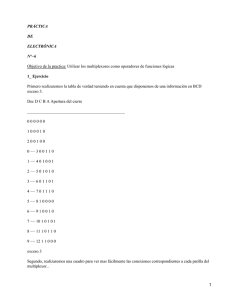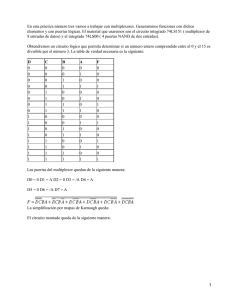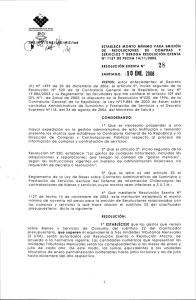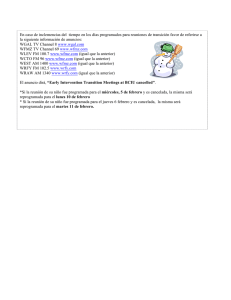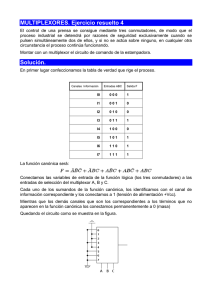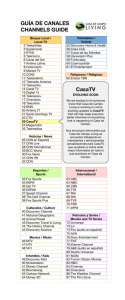Time-Division Multiplexor
Anuncio
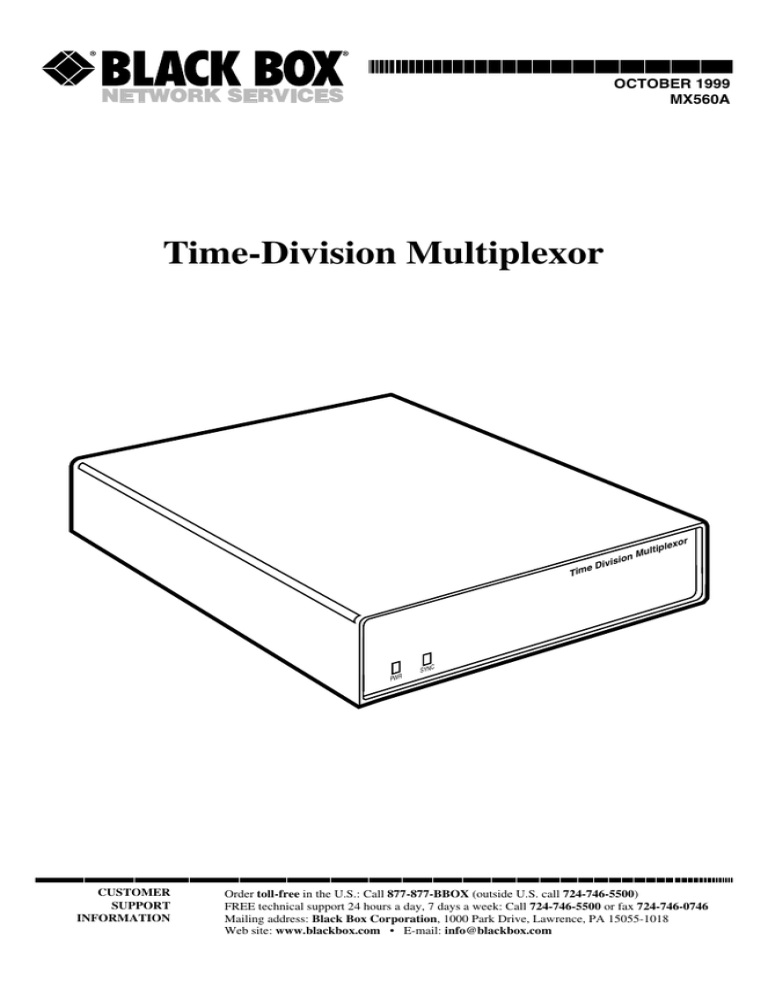
OCTOBER 1999 MX560A Time-Division Multiplexor e Tim PWR CUSTOMER SUPPORT INFORMATION n isio xor iple Mult Div SYNC Order toll-free in the U.S.: Call 877-877-BBOX (outside U.S. call 724-746-5500) FREE technical support 24 hours a day, 7 days a week: Call 724-746-5500 or fax 724-746-0746 Mailing address: Black Box Corporation, 1000 Park Drive, Lawrence, PA 15055-1018 Web site: www.blackbox.com • E-mail: [email protected] TIME-DIVISION MULTIPLEXOR FEDERAL COMMUNICATIONS COMMISSION AND CANADIAN DEPARTMENT OF COMMUNICATIONS RADIO FREQUENCY INTERFERENCE STATEMENTS This equipment generates, uses, and can radiate radio frequency energy and if not installed and used properly, that is, in strict accordance with the manufacturer’s instructions, may cause interference to radio communication. It has been tested and found to comply with the limits for a Class A computing device in accordance with the specifications in Subpart J of Part 15 of FCC rules, which are designed to provide reasonable protection against such interference when the equipment is operated in a commercial environment. Operation of this equipment in a residential area is likely to cause interference, in which case the user at his own expense will be required to take whatever measures may be necessary to correct the interference. Changes or modifications not expressly approved by the party responsible for compliance could void the user’s authority to operate the equipment. This digital apparatus does not exceed the Class A limits for radio noise emission from digital apparatus set out in the Radio Interference Regulation of Industry Canada. Le présent appareil numérique n’émet pas de bruits radioélectriques dépassant les limites applicables aux appareils numériques de la classe A prescrites dans le Règlement sur le brouillage radioélectrique publié par Industrie Canada. 1 TIME-DIVISION MULTIPLEXOR NORMAS OFICIALES MEXICANAS (NOM) ELECTRICAL SAFETY STATEMENT INSTRUCCIONES DE SEGURIDAD 1. Todas las instrucciones de seguridad y operación deberán ser leídas antes de que el aparato eléctrico sea operado. 2. Las instrucciones de seguridad y operación deberán ser guardadas para referencia futura. 3. Todas las advertencias en el aparato eléctrico y en sus instrucciones de operación deben ser respetadas. 4. Todas las instrucciones de operación y uso deben ser seguidas. 5. El aparato eléctrico no deberá ser usado cerca del agua—por ejemplo, cerca de la tina de baño, lavabo, sótano mojado o cerca de una alberca, etc.. 6. El aparato eléctrico debe ser usado únicamente con carritos o pedestales que sean recomendados por el fabricante. 7. El aparato eléctrico debe ser montado a la pared o al techo sólo como sea recomendado por el fabricante. 8. Servicio—El usuario no debe intentar dar servicio al equipo eléctrico más allá a lo descrito en las instrucciones de operación. Todo otro servicio deberá ser referido a personal de servicio calificado. 9. El aparato eléctrico debe ser situado de tal manera que su posición no interfiera su uso. La colocación del aparato eléctrico sobre una cama, sofá, alfombra o superficie similar puede bloquea la ventilación, no se debe colocar en libreros o gabinetes que impidan el flujo de aire por los orificios de ventilación. 10. El equipo eléctrico deber ser situado fuera del alcance de fuentes de calor como radiadores, registros de calor, estufas u otros aparatos (incluyendo amplificadores) que producen calor. 11. El aparato eléctrico deberá ser connectado a una fuente de poder sólo del tipo descrito en el instructivo de operación, o como se indique en el aparato. 2 TIME-DIVISION MULTIPLEXOR 12. Precaución debe ser tomada de tal manera que la tierra fisica y la polarización del equipo no sea eliminada. 13. Los cables de la fuente de poder deben ser guiados de tal manera que no sean pisados ni pellizcados por objetos colocados sobre o contra ellos, poniendo particular atención a los contactos y receptáculos donde salen del aparato. 14. El equipo eléctrico debe ser limpiado únicamente de acuerdo a las recomendaciones del fabricante. 15. En caso de existir, una antena externa deberá ser localizada lejos de las lineas de energia. 16. El cable de corriente deberá ser desconectado del cuando el equipo no sea usado por un largo periodo de tiempo. 17. Cuidado debe ser tomado de tal manera que objectos liquidos no sean derramados sobre la cubierta u orificios de ventilación. 18. Servicio por personal calificado deberá ser provisto cuando: A: El cable de poder o el contacto ha sido dañado; u B: Objectos han caído o líquido ha sido derramado dentro del aparato; o C: El aparato ha sido expuesto a la lluvia; o D: El aparato parece no operar normalmente o muestra un cambio en su desempeño; o E: El aparato ha sido tirado o su cubierta ha sido dañada. 3 TIME-DIVISION MULTIPLEXOR TRADEMARKS UL® is a registered trademark of Underwriters Laboratories Incorporated. The trademarks mentioned in this manual are the sole property of their owners. 4 TIME-DIVISION MULTIPLEXOR Contents 1. Specifications . . . . . . . . . . . . . . . . . . . . . . . . . . . . . . . . . . . . . . . . . . . . . . . . . . . . . 6 2. Introduction . . . . . . . . . . . . . . . . . . . . . . . . . . . . . . . . . . . . . . . . . . . . . . . . . . . . . . 7 3. Setup and Installation . . . . . . . . . . . . . . . . . . . . . . . . . . . . . . . . . . . . . . . . . . . . . . 8 3.1 Installation. . . . . . . . . . . . . . . . . . . . . . . . . . . . . . . . . . . . . . . . . . . . . . . . . . . . . 8 3.2 Character Length . . . . . . . . . . . . . . . . . . . . . . . . . . . . . . . . . . . . . . . . . . . . . . . 8 3.3 Stop-Bit Reduction . . . . . . . . . . . . . . . . . . . . . . . . . . . . . . . . . . . . . . . . . . . . . . 8 3.4 Channel 1 Sync/Async . . . . . . . . . . . . . . . . . . . . . . . . . . . . . . . . . . . . . . . . . . . 8 3.5 Equipment Grounding . . . . . . . . . . . . . . . . . . . . . . . . . . . . . . . . . . . . . . . . . . . 8 3.6 Factory Straps . . . . . . . . . . . . . . . . . . . . . . . . . . . . . . . . . . . . . . . . . . . . . . . . . . 8 3.7 Board Layout and Jumper Settings . . . . . . . . . . . . . . . . . . . . . . . . . . . . . . . . . 9 5 TIME-DIVISION MULTIPLEXOR 1. Specifications Applications—RS-232 sync or async 2 sub-channel multiplexor Capacity—(2) sync or (1) sync and (1) async RS-232 terminals, (1) sync RS-232 modem Data Format—Data coding: synchronous or asynchronous Data Rates—Async 600 bps to 19.2 kbps or sync up to 19.2 kbps with 38.4 kbps composite Data Interface—EIA RS-232C Connectors—(3) DB25 female Enclosure—Aluminum Approvals—FCC Class A, UL®, CSA Operating Temperature—32 to 122°F (0 to 50°C) Relative Humidity—Up to 90% noncondensing Altitude—Up to 10,000 feet (3048 m) Power Requirements—110- or 220-VAC, 47-63 Hz, 5 W external wallmount transformer Size—2"H x 8.3"W x 6.1"D (5.1 x 21.1 x 15.5 cm) Weight—2.25 lb. (1 kg) 6 TIME-DIVISION MULTIPLEXOR 2. Introduction The Time-Division Multiplexor is a full-duplex, RS-232, 2-channel, time-division multiplexor with an independent switch-selectable V.14/V.22-compliant asynchronous-to-synchronous interface adapter on sub-channel 1. The composite channel is designed to interface directly with a high-speed synchronous modem via a straight-through cable. The unit operates by sequentially selecting a bit of data from the sub-channel and then multiplexing it onto the composite channel. Each sub-channel can operate at 1⁄2 the composite channel rate. Standard DB25 female connectors are provided on all sub-channels as well as the composite channel. Power is provided by an external transformer connected through J1 (Power) on the rear of the mutliplexor. The external power transformer is UL and CSA approved. Front-panel LEDs include SYNC and Power. When two TDMs are in sync with each other and data transmission is possible, the SYNC LED should be lit. The Power LED should be on at all times. Three DB25 female connectors are provided for connecting the modem on the composite port (J2) and two terminals. Channel 1 (J3) can be used for synchronous or asynchronous operation. Channel 2 (J4) can be operated only as a synchronous channel. Channel 1 must be used as either sync or async on both ends of the circuit for the multiplexor to function properly. Host Processor Sync Terminal Modem Async Terminal Modem Time-Division Multiplexor Time-Division Multiplexor Figure 2-1. Typical Application. 7 TIME-DIVISION MULTIPLEXOR 3. Setup and Installation 3.1 Installation Set switches to match the required configurations as described in Sections 3.2 through 3.5. The cabling between each device and the Time-Division Multiplexor must be terminated with male connectors. Character length and stop-bit reduction only apply to channel 1 when it is selected for asynchronous operation. 3.2 Character Length SW1 positions 1 and 2 select the character length. The character length includes the start, stop, and any parity bits. 10-bit length is 1 start bit, 8 data bits, and 1 stop bit. Figure 3-1 outlines all the available character bit lengths available. 3.3 Stop-Bit Reduction SW1 position 3 selects the percentage of stop-bit reduction to occur when the sync rate is faster than the async rate. Setting SW1 position 3 to ON will select 25% stopbit reduction. Setting SW1 position 3 to OFF will select 12.5% stop-bit reduction. 3.4 Channel 1 Sync/Async SW1 position 5 selects channel 1 as a sync or async channel. This selection must be the same on both ends of the circuit for the units to operate correctly. Setting SW1 position 5 to ON will select asynchronous operation on channel 1. Setting SW1 position 5 to OFF will select synchronous operation on channel 1. 3.5 Equipment Grounding SW1 position 6 connects Pin #1 (Chassis Ground) to Pin #7 (Signal Ground). 3.6 Factory Straps SW1 position 4 is not used. It must be in the OFF position. Jumpers JP1 through JP3 must be installed for proper operation. 8 Power Sync { Character Length — SW1 1 2 Length OFF OFF 10 Bits ON OFF 11 Bits OFF ON 8 Bits ON ON 9 Bits 25% Stop Bit Reduction = ON/12.5% Stop Bit Reduction = OFF Factory Test, MUST BE OFF Chan 1 Async = ON/Chan 1 Sync = OFF Signal Ground Connected to Chassis Ground = ON Character Length J4 J3 2 JP1 Factory Test Jumpers MUST BE IN J2 1 JP2 JP3 J1 Channel 2 (Terminal) Channel 1 (Terminal) OFF Composite (Modem) ON Power Connector TIME-DIVISION MULTIPLEXOR 3.7 Board Layout and Jumper Settings 3 4 5 6 Figure 3-1. Board Layout. 9 © Copyright 1999. Black Box Corporation. All rights reserved. 1000 Park Drive • Lawrence, PA 15055-1018 • 724-746-5500 • Fax 724-746-0746
